
B.Crowell - Conservation Laws, Vol
.2.pdf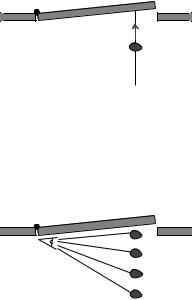
An overhead view of a piece of putty being thrown at a door. Even though the putty is neither spinning nor traveling along a curve, we must define it has having some kind of “rotation” because it is able to make the door rotate.
As seen by someone standing at the axis, the putty changes its angular position. We therefore define it as having angular momentum.
there is a trick for finding out if an egg is raw or hardboiled. If you spin a hardboiled egg and then stop it briefly with your finger, it stops dead. But if you do the same with a raw egg, it springs back into rotation because the soft interior was still swirling around within the momentarily motionless shell. The pattern of flow of the liquid part is presumably very complex and nonuniform due to the asymmetric shape of the egg and the different consistencies of the yolk and the white, but there is apparently some way to describe the liquid’s total amount of rotation with a single number, of which some percentage is given back to the shell when you release it.
The best strategy is to devise a way of defining the amount of rotation of a single small part of a system. The amount of rotation of a system such as a cyclone will then be defined as the total of all the contributions from its many small parts.
The quest for a conserved quantity of rotation even requires us to broaden the rotation concept to include cases where the motion doesn’t repeat or even curve around. If you throw a piece of putty at a door, the door will recoil and start rotating. The putty was traveling straight, not in a circle, but if there is to be a general conservation law that can cover this situation, it appears that we must describe the putty as having had some “rotation,” which it then gave up to the door. The best way of thinking about it is to attribute rotation to any moving object or part of an object that changes its angle in relation to the axis of rotation. In the putty-and- door example, the hinge of the door is the natural point to think of as an axis, and the putty changes its angle as seen by someone standing at the hinge. For this reason, the conserved quantity we are investigating is called angular momentum. The symbol for angular momentum can’t be “a” or “m,” since those are used for acceleration and mass, so the symbol L is arbitrarily chosen instead.
Imagine a 1-kg blob of putty, thrown at the door at a speed of 1 m/s, which hits the door at a distance of 1 m from the hinge. We define this blob to have 1 unit of angular momentum. When it hits the door, it will give up most of its own angular momentum to the door, which will recoil and start rotating.
Experiments show, not surprisingly, that a 2-kg blob thrown in the same way makes the door rotate twice as fast, so the angular momentum of the putty blob must be proportional to mass,
L m .
Similarly, experiments show that doubling the velocity of the blob will have a doubling effect on the result, so its angular momentum must be proportional to its velocity as well,
L mv .
You have undoubtedly had the experience of approaching a closed door with one of those bar-shaped handles on it and pushing on the wrong side, the side close to the hinges. You feel like an idiot, because you have so little leverage that you can hardly budge the door. The same would be true with the putty blob. Experiments would show that the amount of rotation the
Section 5.1 Conservation of Angular Momentum |
91 |
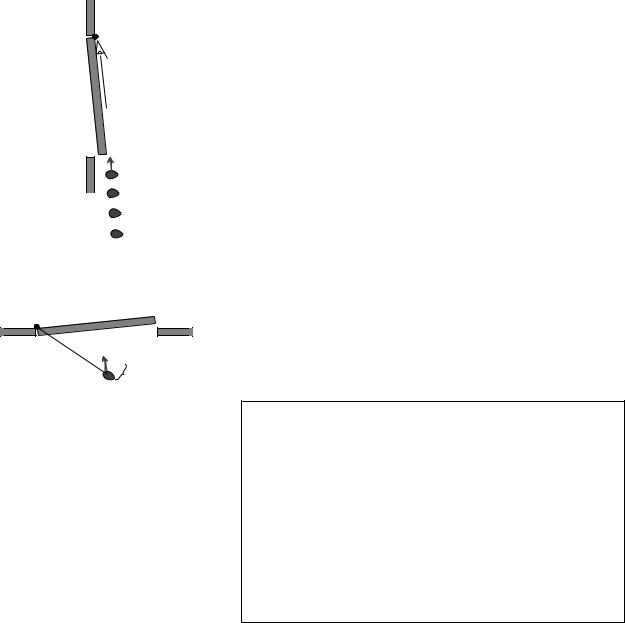
A putty blob thrown directly at the axis has no angular motion, and therefore no angular momentum. It will not cause the door to rotate.
v
v
Only the component of the velocity vector perpendicular to the line connecting the object to the axis should be counted into the definition of angular momentum.
blob can give to the door is proportional to the distance, r, from the axis of rotation, so angular momentum must be proportional to r as well,
L mvr .
We are almost done, but there is one missing ingredient. We know on grounds of symmetry that a putty ball thrown directly inward toward the hinge will have no angular momentum to give to the door. After all, there would not even be any way to decide whether the ball’s rotation was clockwise or counterclockwise in this situation. It is therefore only the component of the blob’s velocity vector perpendicular to the door that should be counted in its angular momentum,
L = m v r .
More generally, v should be thought of as the component of the object’s velocity vector that is perpendicular to the line joining the object to the axis of rotation.
We find that this equation agrees with the definition of the original putty blob as having one unit of angular momentum, and we can now see that the units of angular momentum are (kg.m/s) . m, i.e. kg.m2/s. This gives us a way of calculating the angular momentum of any material object or any system consisting of material objects:
angular momentum of a material object
The angular momentum of a moving particle is
L = |
m v r , |
where m is its mass, v is |
the component of its velocity |
perpendicular to the line joining it to the axis of rotation, and r is its distance from the axis of rotation. Positive and negative signs of angular momentum are used to describe opposite directions of rotation.
The angular momentum of a finite-sized object or a system of many objects is found by dividing it up into many small parts, applying the equation to each part, and adding to find the total amount of angular momentum.
Note that r is not necessarily the radius of a circle. (As implied by the qualifiers, matter isn’t the only thing that can have angular momentum. Light can also have angular momentum, and the above equation would not apply to light.)
Conservation of angular momentum has been verified over and over again by experiment, and is now believed to be one of the three most fundamental principles of physics, along with conservation of energy and momentum.
92 |
Chapter 5 Conservation of Angular Momentum |

A figure skater pulls in her arms so that she can execute a spin more rapidly.
A view of the earth-moon system from above the north pole. All distances have been highly distorted for legibility. The earth’s rotation is counterclockwise from this point of view (arrow). The moon’s gravity creates a bulge on the side near it, because its gravitational pull is stronger there, and an “anti-bulge” on the far side, since its gravity there is weaker. For simplicity, let’s focus on the tidal bulge closer to the moon. Its frictional force is trying to slow down the earth’s rotation, so its force on the earth’s solid crust is toward the bottom of the figure. By Newton’s third law, the crust must thus make a force on the bulge which is toward the top of the figure. This causes the bulge to be pulled forward at a slight angle, and the bulge’s gravity therefore pulls the moon forward, accelerating its orbital motion about the earth and flinging it outward.
Example: a figure skater pulls her arms in
When a figure skater is twirling, there is very little friction between her and the ice, so she is essentially a closed system, and her angular momentum is conserved. If she pulls her arms in, she is decreasing r for all the atoms in her arms. It would violate conservation of angular momentum if she then continued rotating at the same speed, i.e. taking the same amount of time for each revolution, her arms’ contributions to her angular momentum would have decreased, and no other part of her would have increased its angular momentum. This is impossible because it would violate conservation of angular momentum. If her total angular momentum is to remain constant, the decrease in r for her arms must be compensated for by an overall increase in her rate of rotation. That is, by pulling her arms in, she substantially reduces the time for each rotation.
Example: Earth’s slowing rotation and the receding moon
As noted in chapter 1, the earth’s rotation is actually slowing down very gradually, with the kinetic energy being dissipated as heat by friction between the land and the tidal bulges raised in the seas by the earth’s gravity. Does this mean that angular momentum is not really perfectly conserved? No, it just means that the earth is not quite a closed system by itself. If we consider the earth and moon as a system, then the angular momentum lost by the earth must be gained by the moon somehow. In fact very precise measurements of the distance between the earth and the moon have been carried out by bouncing laser beams off of a mirror left there by astronauts, and these measurements show that the moon is receding from the earth at a rate of 2 millimeters per year! The moon’s greater value of r means that it has a greater angular momentum, and the increase turns out to be exactly the amount lost by the earth. In the days of the dinosaurs, the days were significantly shorter, and the moon was closer and appeared bigger in the sky.
But what force is causing the moon to speed up, drawing it out into a larger orbit? It is the gravitational forces of the earth’s tidal bulges. The effect is described qualitatively in the caption of the figure. The result would obviously be extremely difficult to calculate directly, and this is one of those situations where a conservation law allows us to make precise quantitative statements about the outcome of a process when the calculation of the process itself would be prohibitively complex.
Restriction to rotation in a plane
Is angular momentum a vector or a scalar? It does have a direction in space, but it’s a direction of rotation, not a straight-line direction like the directions of vectors such as velocity or force. It turns out that there is a way of defining angular momentum as a vector, but in this book the examples will be confined to a single plane of rotation, i.e. effectively two-dimen- sional situations. In this special case, we can choose to visualize the plane of rotation from one side or the other, and to define clockwise and counterclockwise rotation as having opposite signs of angular momentum.
Section 5.1 Conservation of Angular Momentum |
93 |

Discussion Question
Conservation of plain old momentum, p, can be thought of as the greatly expanded and modified descendant of Galileo’s original principle of inertia, that no force is required to keep an object in motion. The principle of inertia is counterintuitive, and there are many situations in which it appears superficially that a force is needed to maintain motion, as maintained by Aristotle. Think of a situation in which conservation of angular momentum, L, also seems to be violated, making it seem incorrectly that something external must act on a closed system to keep its angular momentum from “running down.”
5.2 Angular Momentum in Planetary Motion
sun |
h |
b
v v
We now discuss the application of conservation of angular momentum to planetary motion, both because of its intrinsic importance and because it is a good way to develop a visual intuition for angular momentum.
Kepler’s law of equal areas states that the area swept out by a planet in a certain length of time is always the same. Angular momentum had not been invented in Kepler’s time, and he did not even know the most basic physical facts about the forces at work. He thought of this law as an entirely empirical and unexpectedly simple way of summarizing his data, a rule that succeeded in describing and predicting how the planets sped up and slowed down in their elliptical paths. It is now fairly simple, however, to show that the equal area law amounts to a statement that the planet’s angular momentum stays constant.
There is no simple geometrical rule for the area of a pie wedge cut out of an ellipse, but if we consider a very short time interval, as shown in the figure, the shaded shape swept out by the planet is very nearly a triangle. We do know how to compute the area of a triangle. It is one half the product of the base and the height:
area |
= |
1 |
bh . |
|
|
2 |
|
We wish to relate this to angular momentum, which contains the variables r and v . If we consider the sun to be the axis of rotation, then the variable r is identical to the base of the triangle, r=b. Referring to the magnified portion of the figure, v can be related to h, because the two right triangles are similar:
h |
= |
|
v |
distance traveled |
|
v |
The area can thus be rewritten as
|
|
1 r |
v distance traveled |
|||
area |
= |
|
|
|
. |
|
|
|
|
||||
|
|
2 |
|
v |
|
|
|
|
|
|
|
|
|
The distance traveled equals |v| t, so this simplifies to
area |
= 21 r v t . |
We have found the following relationship between angular momentum and the rate at which area is swept out:
94 |
Chapter 5 Conservation of Angular Momentum |

L |
= |
2m area . |
|
|
t |
The factor of 2 in front is simply a matter of convention, since any conserved quantity would be an equally valid conserved quantity if you multiplied it by a constant. The factor of m was not relevant to Kepler, who did not know the planets’ masses, and who was only describing the motion of one planet at a time.
We thus find that Kepler’s equal-area law is equivalent to a statement that the planet’s angular momentum remains constant. But wait, why should it remain constant? — the planet is not a closed system, since it is being acted on by the sun’s gravitational force. There are two valid answers. The first is that it is actually the total angular momentum of the sun plus the planet that is conserved. The sun, however, is millions of times more massive than the typical planet, so it accelerates very little in response to the planet’s gravitational force. It is thus a good approximation to say that the sun doesn’t move at all, so that no angular momentum is transferred between it and the planet.
The second answer is that to change the planet’s angular momentum requires not just a force but a force applied in a certain way. In section 5.4 we discuss the transfer of angular momentum by a force, but the basic idea here is that a force directly in toward the axis does not change the angular momentum.
Discussion Questions
A. Suppose an object is simply traveling in a straight line at constant speed. If
we pick some point not on the line and call it the axis of rotation, is area swept
out by the object at a constant rate? Would it matter if we chose a different axis?
B. The figure below is a strobe photo of a pendulum bob, taken from underneath the pendulum looking straight up. The black string can’t be seen in the photograph. The bob was given a slight sideways push when it was released, so it did not swing in a plane. The bright spot marks the center, i.e. the position the bob would have if it hung straight down at us. Does the bob’s angular momentum appear to remain constant if we consider the center to be the axis of rotation? What if we choose a different axis?
Discussion question A.
Discussion question B.
Section 5.2 Angular Momentum in Planetary Motion |
95 |
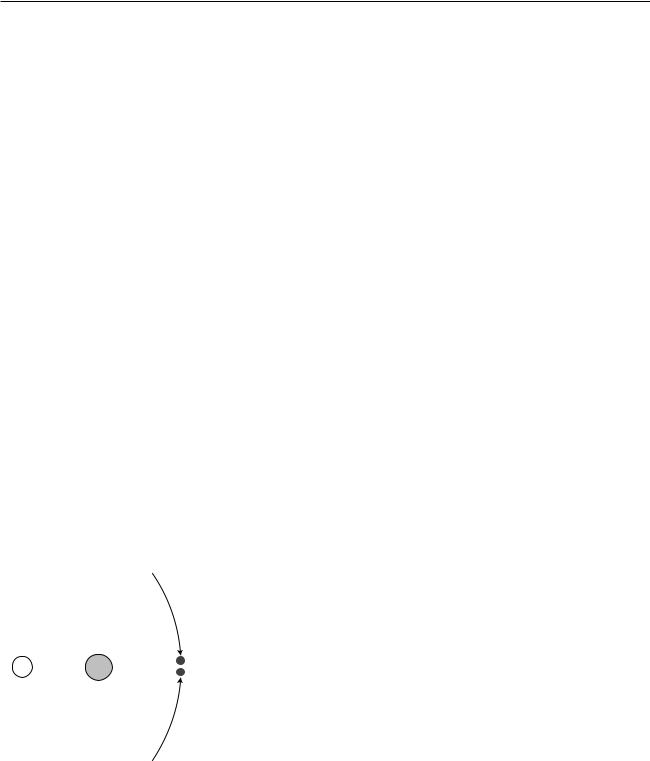
5.3 Two Theorems About Angular Momentum
With plain old momentum, p, we had the freedom to work in any inertial frame of reference we liked. The same object could have different values of momentum in two different frames, if the frames were not at rest with respect to each other. Conservation of momentum, however, would be true in either frame. As long as we employed a single frame consistently throughout a calculation, everything would work.
The same is true for angular momentum, and in addition there is an ambiguity that arises from the definition of an axis of rotation. For a wheel, the natural choice of an axis of rotation is obviously the axle, but what about an egg rotating on its side? The egg has an asymmetric shape, and thus no clearly defined geometric center. A similar issue arises for a cyclone, which does not even have a sharply defined shape, or for a complicated machine with many gears. The following theorem, the first of two presented in this section without proof, explains how to deal with this issue. Although I have put descriptive titles above both theorems, they have no generally accepted names.
|
|
choice of axis theorem |
|
|
|
|
It is entirely arbitrary what point one defines as the axis for |
|
|
|
|
purposes of calculating angular momentum. If a closed system's |
|
|
|
|
angular momentum is conserved when calculated with one |
|
|
|
|
choice of axis, then it will also be conserved for any other |
|
|
|
|
choice of axis. Likewise, any inertial frame of reference may be |
|
|
|
|
used. |
|
|
|
|
|
|
|
|
|
Example: colliding asteroids described with different axes |
||
|
|
Observers on planets A and B both see the two asteroids collid- |
||
|
|
ing. The asteroids are of equal mass and their impact speeds are |
||
|
|
the same. Astronomers on each planet decide to define their own |
||
|
|
planet as the axis of rotation. Planet A is twice as far from the |
||
|
|
collision as planet B. The asteroids collide and stick. For simplic- |
||
|
|
ity, assume planets A and B are both at rest. |
||
|
|
With planet A as the axis, the two asteroids have the same |
||
|
|
amount of angular momentum, but one has positive angular |
||
|
|
momentum and the other has negative. Before the collision, the |
||
A |
B |
total angular momentum is therefore zero. After the collision, the |
||
two asteroids will have stopped moving, and again the total |
||||
|
|
|||
|
|
angular momentum is zero. The total angular momentum both |
||
|
|
before and after the collision is zero, so angular momentum is |
||
|
|
conserved if you choose planet A as the axis. |
||
|
|
The only difference with planet B as axis is that r is smaller by a |
||
|
|
factor of two, so all the angular momenta are halved. Even |
||
|
|
though the angular momenta are different than the ones calcu- |
||
|
|
lated by planet A, angular momentum is still conserved. |
||
96 |
Chapter 5 Conservation of Angular Momentum |
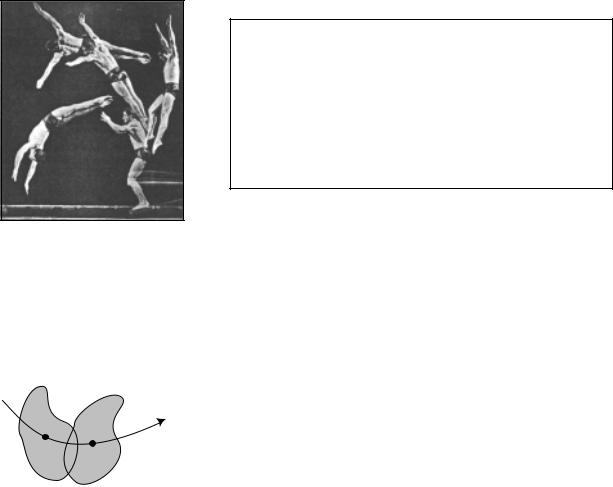
Everyone has a strong tendency to think of the diver as rotating about his own center of mass. However, he is flying in an arc, and he also has angular momentum because of this motion.
This rigid object has angular momentum both because it is spinning about its center of mass and because it is moving through space.
The earth spins on its own axis once a day, but simultaneously travels in its circular one-year orbit around the sun, so any given part of it traces out a complicated loopy path. It would seem difficult to calculate the earth’s angular momentum, but it turns out that there is an intuitively appealing shortcut: we can simply add up the angular momentum due to its spin plus that arising from its center of mass’s circular motion around the sun. This is a special case of the following general theorem:
spin theorem
An object's angular momentem with respect to some outside axis A can be found by adding up two parts:
(1)The first part is the object's angular momentum found by using its own center of mass as the axis, i.e. the angular momentum the object has because it is spinning.
(2)The other part equals the angular momentum that the object would have with respect to the axis A if it had all its
mass concentrated at and moving with its center of mass.
Example: a system with its center of mass at rest
In the special case of an object whose center of mass is at rest, the spin theorem implies that the object’s angular momentum is the same regardless of what axis we choose. (This is an even stronger statement than the choice of axis theorem, which only guarantees that angular momentum is conserved for any given choice of axis, without specifying that it is the same for all such choices.)
Example: angular momentum of a rigid object
Question: A motorcycle wheel has almost all its mass concentrated at the outside. If the wheel has mass m and radius r, and the time required for one revolution is T, what is the spin part of its angular momentum?
Solution: This is an example of the commonly encountered special case of rigid motion, as opposed to the rotation of a system like a hurricane in which the different parts take different amounts of time to go around. We don’t really have to go through a laborious process of adding up contributions from all the many parts of a wheel, because they are all at about the same distance from the axis, and are all moving around the axis at about the same speed. The velocity is all perpendicular to the spokes,
v = v
=(circumference)/T
=2πr/T
and the angular momentum of the wheel about its center is
L= mv r
=m(2πr/T)r
=2πmr2/T .
Note that although the factors of 2π in this expression is peculiar to a wheel with its mass concentrated on the rim, the proportionality to m/T would have been the same for any other rigidly rotating object. Although an object with a noncircular shape does not have a radius, it is also true in general that angular momentum is proportional to the square of the object’s size for fixed values of m and T. For instance doubling an object’s size
Section 5.3 Two Theorems About Angular Momentum |
97 |
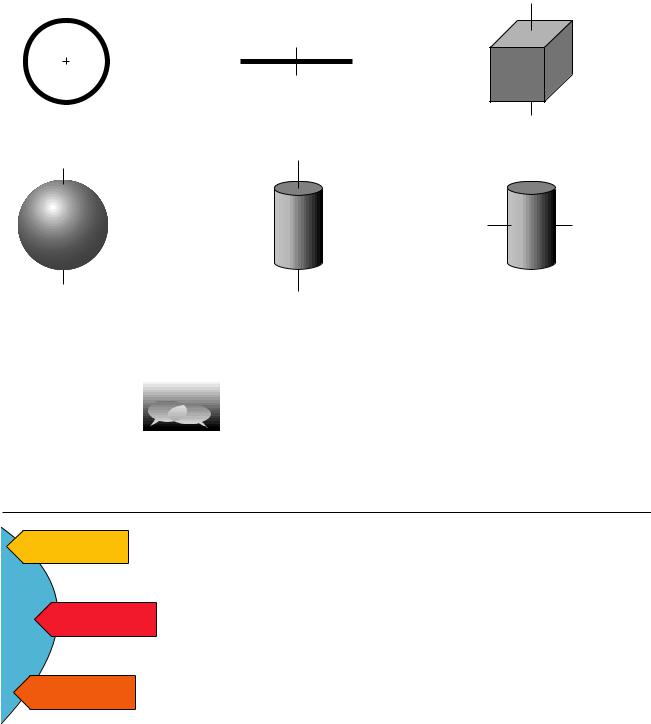
L=2πmR2/T
wheel or hoop of radius R, with its mass concentrated on the rim
L=4π/5mR2/T
doubles both the v and r factors in the contribution of each of its parts to the total angular momentum, resulting in an overall factor of four increase.
The figure shows some examples of angular momenta of various shapes rotating about their centers of mass. The equations for their angular momenta were derived using calculus, using methods discussed in supplement 2-7. Do not memorize these equations!
L=π/6mb2/T
thin rod of length b rotating end over end
L=πmR2/T
L=π/3mb2/T
cube with sides of length b
L=π/2mR2/T +π/6mb2/T
sphere of radius R with |
cylinder of radius R |
cylinder of radius R and |
uniform density throughout |
rotating about its axis |
length b rotating end over end |
Discussion Question
In the example of the colliding asteroids, suppose planet A was moving toward the top of the page, at the same speed as the bottom asteroid. How would planet A’s astronomers describe the angular momenta of the asteroids? Would angular momentum still be conserved?
5.4 Torque: the Rate of Transfer of Angular Momentum
energy
power = rate of
transferring energy
system
momentum
force = rate of transferring momentum
angular
momentum
torque = rate of transferring angular momentum
Force can be interpreted as the rate of transfer of momentum. The equivalent in the case of angular momentum is called torque (rhymes with “fork”). Where force tells us how hard we are pushing or pulling on something, torque indicates how hard we are twisting on it. Torque is represented by the Greek letter tau, τ, and the rate of change of an object’s angular momentum equals the total torque acting on it,
τtotal = L/ t .
(If the angular momentum does not change at a constant rate, the total torque equals the slope of the tangent line on a graph of L versus t.)
As with force and momentum, it often happens that angular momentum recedes into the background and we focus our interest on the torques. The torque-focused point of view is exemplified by the fact that many scientifically untrained but mechanically apt people know all about torque, but none of them have heard of angular momentum. Car enthusiasts
98 |
Chapter 5 Conservation of Angular Momentum |

The plane’s four engines produce zero total torque but not zero total force.
axis |
F |
F
The simple physical situation we use to derive an equation for torque. A force that points directly in at or out away from the axis produces neither clockwise nor counterclockwise angular momentum. A force in the perpendicular direction does transfer angular momentum.
eagerly compare engines’ torques, and there is a tool called a torque wrench which allows one to apply a desired amount of torque to a screw and avoid overtightening it.
Torque distinguished from force
Of course a force is necessary in order to create a torque — you can’t twist a screw without pushing on the wrench — but force and torque are two different things. One distinction between them is direction. We use positive and negative signs to represent forces in the two possible directions along a line. The direction of a torque, however, is clockwise or counterclockwise, not a linear direction.
The other difference between torque and force is a matter of leverage. A given force applied at a door’s knob will change the door’s angular momentum twice as rapidly as the same force applied halfway between the knob and the hinge. The same amount of force produces different amounts of torque in these two cases.
It is possible to have a zero total torque with a nonzero total force. An airplane with four jet engines would be designed so that their forces are balanced on the left and right. Their forces are all in the same direction, but the clockwise torques of two of the engines are canceled by the counterclockwise torques of the other two, giving zero total torque.
Conversely we can have zero total force and nonzero total torque. A merry-go-round’s engine needs to supply a nonzero torque on it to bring it up to speed, but there is zero total force on it. If there was not zero total force on it, its center of mass would accelerate!
Relationship between force and torque
How do we calculate the amount of torque produced by a given force? Since it depends on leverage, we should expect it to depend on the distance between the axis and the point of application of the force. We’ll derive an equation relating torque to force for a particular very simple situation, and state without proof that the equation actually applies to all situations.
Consider a pointlike object which is initially at rest at a distance r from the axis we have chosen for defining angular momentum. We first observe that a force directly inward or outward, along the line connecting the axis to the object, does not impart any angular momentum to the object.
A force perpendicular to the line connecting the axis and the object does, however, make the object pick up angular momentum. Newton’s second law gives
a = F/m ,
and assuming for simplicity that the force is constant, the constant acceleration equation a= v/ t allows us to find the velocity the object acquires after a time t,
v = F t/m .
We are trying to relate force to a change in angular momentum, so we multiply both sides of the equation by mr to give
m vr = F tr
L = F tr .
Section 5.4 Torque: the Rate of Transfer of Angular Momentum |
99 |
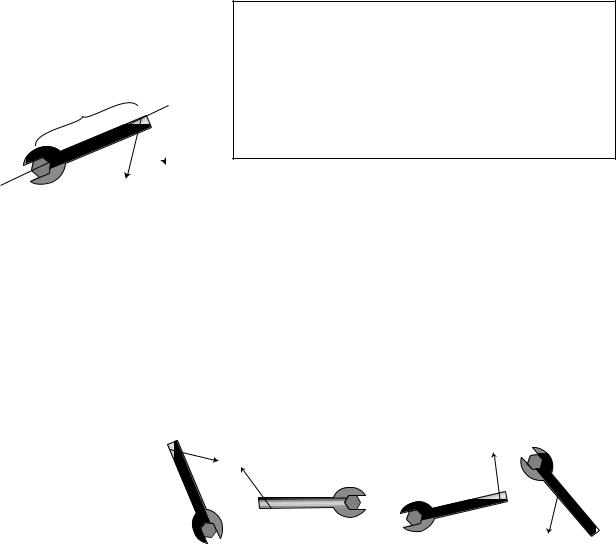
r
 F
F
F
The geometric relationships refered to in the relationship between force and torque.
Dividing by Dt gives the torque:
DL/Dt = Fr
t = Fr .
If a force acts at an angle other than 0 or 90° with respect to the line joining the object and the axis, it would be only the component of the force perpendicular to the line that would produce a torque,
t = F r .
Although this result was proved under a simplified set of circumstances, it is more generally valid.
relationship between force and torque
The rate at which a force transfers angular momentum to an object, i.e. the torque produced by the force, is given by
|τ| = r |F | ,
where r is the distance from the axis to the point of application
of the force, and F is the component of the force that is perpendicular to the line joining the axis to the point of
application.
The equation is stated with absolute value signs because the positive and negative signs of force and torque indicate different things, so there is no useful relationship between them. The sign of the torque must be found by physical inspection of the case at hand.
From the equation, we see that the units of torque can be written as newtons multiplied by meters. Metric torque wrenches are calibrated in N.m, but American ones use foot-pounds, which is also a unit of distance multiplied by a unit of force. We know from our study of mechanical work that newtons multiplied by meters equal joules, but torque is a completely different quantity from work, and nobody writes torques with units of joules, even though it would be technically correct.
Self-Check
Compare the magnitudes and signs of the four torques shown in the figure. [Answer on next page.]
(4)
(1) |
(2) |
(3) |
100 |
Chapter 5 Conservation of Angular Momentum |
